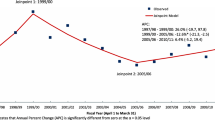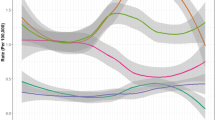Abstract
Background
In assigning manner of death (MOD) for inclusion on death certificates, medical examiners and coroners do not always apply uniform criteria. Previous research indicates surveillance statistics based on death certificates, such as the National Vital Statistics System, grossly miscount unintentional firearm deaths. The National Violent Death Reporting System (NVDRS) has taken steps to reduce variability in manner of death coding by providing uniform criteria for assigning an “abstractor manner of death” (AMD). AMD has five categories: unintentional, suicide, homicide, undetermined, and legal intervention homicide. A previous study found good accuracy of AMD coding for unintentional firearm deaths, all ages, 2003–2006, but a more recent study reported that the NVDRS undercounted self- and other-inflicted unintentional firearm deaths in which both the victim and shooter (for other-inflicted injuries) were under age 15 (2009–2018).
Findings
We replicated the recent study’s sample population, identifying 924 NVDRS incidents from 2009 to 2018 in which both victim and, for other-inflicted injuries, shooter age was under 15 and AMD was homicide, suicide, unintentional or undetermined (there were no legal intervention deaths to children). We assigned a researcher-adjudicated MOD (RMD) by reviewing incident narratives. RMD was compared with AMD and with manner recorded on the death certificate. Based on RMD as the gold standard, the sensitivity, specificity, and predictive values positive and negative of the AMD for unintentional childhood firearm deaths were, respectively, 90%, 99%, 98% and 96%; 86% (24/28) of false negatives were coded by abstractors as homicides. By contrast, death certificate manner had relatively poor sensitivity (63%).
Conclusions
In our sample of 924 deaths, the abstractor manner of death generally agreed with researcher-adjudicated manner of death, though not perfectly, missing 10% of researcher-adjudicated unintentional deaths, mostly because abstractors coded these unintentional deaths as homicides. A sizable minority of false negatives were unintentional deaths where the narrative explicitly noted that adult negligence contributed to a child’s unintentional shooting death. While AMD coding in NVDRS is good, it could be improved if NVDRS coding guidelines explicitly affirmed that potential prosecution for negligent manslaughter is not a contraindication to an AMD of unintentional, provided the firearm was not used to intentionally harm, threaten, or coerce.
Similar content being viewed by others
Introduction
National Vital Statistics System (NVSS) data grossly miscount unintentional firearm injuries, undercounting cases among children and overcounting cases among adults (Barber, 2002; Barber and Hemenway 2011). One reason for these inaccuracies is that when assigning manner of death (MOD) for inclusion on death certificates, coroners and medical examiners do not always apply uniform criteria. (Centers for Disease Control and Prevention 2022; Hanzlick et al. 2015).
An alternative source of data on violent deaths, the National Violent Death Reporting System (NVDRS), takes steps to reduce variability in MOD coding by providing uniform criteria for assigning an “abstractor manner of death” (AMD) (Centers for Disease Control and Prevention 2022). Rules instruct abstractors, for example, to code fatalities from Russian roulette as suicides, regardless of MOD assigned by coroners and medical examiners.
A previous study focusing on early years in the NVDRS, 2003–2006, found that AMD coding for unintentional firearm deaths was accurate (Barber and Hemenway 2011), but a more recent study, published in this journal, reported that the NVDRS greatly undercounted self- and other-inflicted unintentional firearm deaths in which both the victim and (for other-inflicted injuries) the shooter were under age 15 (Vaishnav et al. 2023). In the latter study, the authors reported that between 2009 and 2018 the NVDRS correctly coded only 61% of the unintentional firearm deaths identified by the researchers (Vaishnav et al. 2023). The reason for this discrepancy and the types of cases miscoded is not clear. One possibility we attempted to assess is that the AMD is inaccurate. The current study adopts Vaishnav et al.’s case definition (and study period) to assess the accuracy of AMD relative to the manner determined by our research team after reviewing NVDRS narratives, 2009–2018. We also characterize discordant cases.
Methods
We identified all firearm deaths that occurred among the 39 states that participated in NVDRS at any point between 2009 and 2018 in which victim age was under 15 years of age, and if other-inflicted, the suspect’s age was determined to be under age 15. After reviewing incident narratives, we assigned a researcher-adjudicated MOD (RMD). RMD was compared with AMD and with the manner recorded on the death certificate. Specificity, sensitivity, and predictive values positive (PVP) and negative (PVN) were calculated for the AMD and for death certificate manner based on RMD as the gold standard.
Results
We identified 924 firearm deaths in NVDRS of which 273 were adjudicated by our team as unintentional. Comparing AMD and RMD, the sensitivity, specificity, PVP and PVN of the AMD for unintentional firearm deaths were, respectively, 90%, 99%, 98% and 96% (Table 1). 86% (24/28) of false negatives were coded by abstractors as homicides. At least 25% of the false negatives pertained to cases where the narrative explicitly noted adult negligence (e.g., negligent manslaughter) while also describing an unintentional shooting by a child, or described an unintentional shooting by a child being prosecuted for manslaughter or homicide (not shown). Comparing RMD and death certificate MOD, the sensitivity, specificity, PVP and PVN were, respectively, 63%, 99.9%, 99%, and 86%. By contrast, death certificate manner had relatively poor sensitivity (of 63%).
Discussion
In our sample of 924 deaths, the AMD had high levels of agreement with our researcher-adjudicated manner of death. However, NVDRS abstractors were not perfect, missing 10% of cases our research team identified as unintentional firearm deaths, mostly because abstractors coded unintentional firearm deaths as homicides. While AMD coding in NVDRS is good, it could be improved if NVDRS coding guidelines explicitly affirmed that AMD should be coded as unintentional when the shooter did not intend harm and was not using the firearm to threaten or coerce another person. This includes cases where the shooter or the adult owner of the gun might be held criminally liable for negligent manslaughter, as might be the case if an adolescent unintentionally shoots another during horseplay with a parent’s gun that they assumed was unloaded. This recommendation could be applied to victims of all ages as the logic underlying it directs the abstracter to focus on the shooter’s intent, not on legal definitions of liability.
Data availability
The dataset analyzed during the current study is available by request via the NVDRS Restricted Access Database application process: https://www.cdc.gov/violenceprevention/datasources/nvdrs/dataaccess.html.
Abbreviations
- AMD:
-
Abstractor Manner of Death
- CME:
-
Coroner / Medical Examiner
- DC:
-
Death Certificate
- MOD:
-
Manner of Death
- NVDRS:
-
The National Violent Death Reporting System
- PVP:
-
Positive Predictive Value
- PVN:
-
Negative Predictive Value
- RMD:
-
Researcher–adjudicated Manner of Death
References
Barber C, Hemenway D. Too many or too few unintentional firearm deaths in official U.S. mortality data? Accid Anal Prev. 2011;43(3):724–31.
Barber C, Hemenway D, Hochstadt J, Azrael D. Underestimates of unintentional firearm fatalities: comparing supplementary Homicide Report data with the National Vital statistics System. Inj Prev. 2002;8(3):252–6.
Centers for Disease Control and Prevention, for IP NC. and C. National Violent Death Reporting System Web Coding Manuel Version 6.0*. 2022; https://www.cdc.gov/violenceprevention/pdf/nvdrs/nvdrsCodingManual.pdf.
Hanzlick RL, Goodin J, Haden-Pinneri K. Mind Your Manners: 20 Years Later. Academic Forensic Pathology. 2015;5(3):380–95. 7. Paulozzi LJ. CDC’s National Violent Death Reporting System: background and methodology. Injury Prevention. 2004;10(1):47–52.
Vaishnav A, Smith GA, Badeti J, Michaels NL. An epidemiological study of unintentional pediatric firearm fatalities in the USA, 2009–2018. Inj Epidemiol. 2023;10(1):25.
Funding
Open access funding provided by Northeastern University Library. Funded by the Joyce Foundation.
Open access funding provided by Northeastern University Library
Author information
Authors and Affiliations
Contributions
Conception and design: D. Azrael, M. Miller, S. Fischer. Analysis and interpretation of the data: D. Azrael, M. Miller, S. Fischer. Drafting of the article: S. Fischer. Critical revision for important intellectual content” D. Azrael, M. Miller, C. Barber. Final approval of the article: D. Azrael, M. Miller, S. Fischer, C. Barber. Provision of study materials or patients: S. Fischer. Statistical expertise: D. Azrael, M. Miller. Obtaining of funding: D. Azrael, M. Miller. Administrative, technical, or logistic support: S. Fischer.Collection and assembly of data: S. Fischer.
Corresponding author
Ethics declarations
Ethics approval and consent to participate
Not applicable.
Consent for publication
Not applicable.
Competing interests
The authors declare no competing interests.
Additional information
Publisher’s Note
Springer Nature remains neutral with regard to jurisdictional claims in published maps and institutional affiliations.
Rights and permissions
Open Access This article is licensed under a Creative Commons Attribution 4.0 International License, which permits use, sharing, adaptation, distribution and reproduction in any medium or format, as long as you give appropriate credit to the original author(s) and the source, provide a link to the Creative Commons licence, and indicate if changes were made. The images or other third party material in this article are included in the article’s Creative Commons licence, unless indicated otherwise in a credit line to the material. If material is not included in the article’s Creative Commons licence and your intended use is not permitted by statutory regulation or exceeds the permitted use, you will need to obtain permission directly from the copyright holder. To view a copy of this licence, visit http://creativecommons.org/licenses/by/4.0/. The Creative Commons Public Domain Dedication waiver (http://creativecommons.org/publicdomain/zero/1.0/) applies to the data made available in this article, unless otherwise stated in a credit line to the data.
About this article
Cite this article
Fischer, S., Miller, M., Barber, C. et al. Accuracy of the national violent death reporting system in identifying unintentional firearm deaths to children by children. Inj. Epidemiol. 11, 29 (2024). https://doi.org/10.1186/s40621-024-00499-0
Received:
Accepted:
Published:
DOI: https://doi.org/10.1186/s40621-024-00499-0




